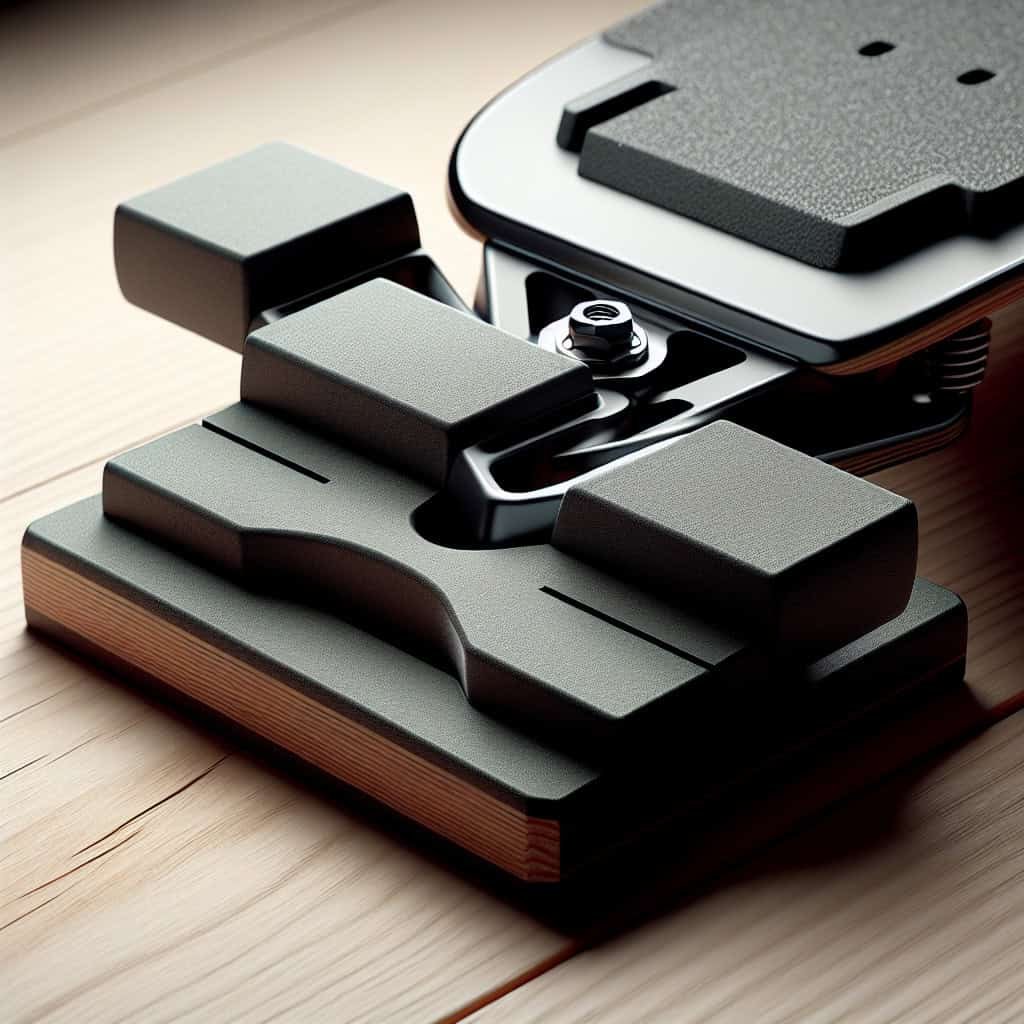In the pursuit of the perfect skateboard ride, it’s essential to pay attention to every element of your board, including the often-overlooked riser pads. These tiny but mighty accessories play a crucial role in enhancing your ride comfort and can make all the difference in your skating experience. So, if you’re wondering how to fine-tune your skateboard’s riser pads to achieve optimal ride comfort, look no further. In this article, we’ll guide you through the simple yet effective steps to adjust your riser pads and unlock a smoother and more enjoyable skateboarding experience.
What are skateboard riser pads?
Definition
Skateboard riser pads, also known as risers, are small rectangular-shaped pieces made from a durable material like rubber or plastic. They are placed between the skateboard deck and the trucks to increase the distance and provide additional clearance. Riser pads come in various thicknesses and types to cater to different riding preferences and terrain.
Function
The primary function of skateboard riser pads is to adjust the height of the skateboard trucks. By adding risers, you can increase the distance between the deck and the trucks, altering the board’s performance. Riser pads can improve ride comfort, enhance stability, and prevent wheelbite, which is the phenomenon of the wheels contacting the deck during turns or tricks.
Why adjust skateboard riser pads?
Improve ride comfort
One of the key reasons to adjust skateboard riser pads is to improve ride comfort. By changing the height of the trucks, you can fine-tune the board’s responsiveness and shock absorption. By adding risers, you increase the distance between the wheels and the deck, reducing the impact and vibrations felt while riding. This can be particularly beneficial for riders who often skate on rough terrain or experience joint pain.
Enhance stability
Another advantage of adjusting skateboard riser pads is the ability to enhance stability. When the trucks are higher, the board becomes less prone to wobbling and feels more controlled during turns and flips. Riders who prefer a stable ride or engage in technical tricks can benefit from adjusting the riser pads to find the optimal balance between stability and maneuverability.
Prevent wheelbite
Wheelbite is a common issue faced by skateboarders, especially those who enjoy carving or performing sharp turns. It occurs when the wheels come into contact with the deck, which can lead to sudden stops and accidents. By adjusting the riser pads, you can increase the clearance between the wheels and the deck, minimizing the chances of wheelbite and allowing for more aggressive turns without any restrictions.

Types of skateboard riser pads
Hard riser pads
Hard riser pads are made from durable materials such as hard plastic or fiberglass. They provide the least amount of flex and are preferred by riders who prioritize stability and responsiveness. Hard riser pads are also suitable for heavy riders or those who engage in high-impact tricks, as they offer maximum support and ensure the board doesn’t bottom out during landings.
Soft/medium riser pads
Soft or medium riser pads are made from rubber or softer plastics. They offer a certain degree of flexibility and shock absorption, making them ideal for riders seeking a smoother and more forgiving ride. Soft/medium riser pads strike a balance between stability and comfort, providing enough support while still allowing for subtle board adjustments and turns.
Shock-absorbing riser pads
Shock-absorbing riser pads are specifically designed to minimize the impact and vibrations felt during skateboarding. They are often made from materials like neoprene or gel, which have excellent shock-absorbing properties. These risers absorb the majority of the vibrations and can help reduce fatigue for riders who spend extended periods on their boards, especially on rough or uneven surfaces.
Angled riser pads
Angled riser pads have a unique design that features a slanted surface. This angled design alters the geometry of the skateboard, affecting how it turns and responds to rider input. Angled riser pads are particularly popular amongst downhill skateboarders or those who enjoy a more surf-like carving experience. They provide a different riding sensation by adjusting the truck angles and can be a great choice for riders looking to add a new dimension to their skateboarding.
Determining the correct riser pad size
Measuring truck clearance
To determine the correct riser pad size, it is crucial to measure the clearance between the skateboard deck and the trucks. Start by removing the trucks from the deck and visually inspect the space. Place the riser pads on the trucks and reattach them to the deck. Ensure that there is sufficient space between the wheels and the deck to prevent wheelbite. Measure this clearance to determine the necessary riser pad size that will provide the desired functionality.
Considering wheel size
Another factor to consider when determining the correct riser pad size is the wheel size. Larger wheels require more clearance, and thus thicker riser pads may be necessary. If you ride with bigger wheels or plan to increase their size, it is essential to choose riser pads that provide enough clearance to avoid wheelbite. Taking into account both the truck clearance and wheel size will help you select the appropriate riser pad size for your specific setup.

Step-by-step guide for adjusting riser pads
Gather necessary tools
Before adjusting your skateboard riser pads, gather the necessary tools. You will need a skate tool or a wrench to remove and reinstall the trucks. It’s also helpful to have a clean cloth or paper towels for cleaning the deck and riser pads.
Remove skateboard trucks
Begin by removing the skateboard trucks from the deck. Use your skate tool or wrench to unscrew the nuts on each truck, gradually loosening them until the trucks can be lifted off the deck. Keep the nuts and washers in a safe place to prevent them from getting lost.
Clean the deck
Take this opportunity to clean the deck thoroughly. Use a clean cloth or paper towels to wipe away any dirt, dust, or debris that may have accumulated on the surface. A clean deck will provide better adhesion for the riser pads and ensure a secure installation.
Identify the riser pad position
Before adjusting the riser pads, identify their current position on the deck. Take note of their orientation and placement, as this will help you reinstall them correctly later. If you are making changes to the riser pad setup, it’s essential to have a reference point for comparison.
Adjusting the riser pad height
Now it’s time to adjust the riser pad height. Depending on your desired ride characteristics, add or remove risers to change the distance between the deck and the trucks. Carefully place the riser pads on the trucks, ensuring they align with the mounting holes. Then, reattach the trucks to the deck, securing them tightly to prevent any shifting or instability.
Reinstalling the skateboard trucks
Once the riser pads are in place, reinstall the skateboard trucks. Begin by placing each truck onto the riser pads, aligning the mounting holes with the corresponding holes on the deck. Thread the nuts back onto the kingpins and tighten them securely with your skate tool or wrench. Double-check that the trucks are firmly attached and that the risers are in the desired position.
Fine-tuning adjustments for ride comfort
Testing different riser pad thicknesses
To optimize ride comfort, it may be necessary to test different riser pad thicknesses. Start with a thickness that matches your current setup, and then gradually experiment with thicker or thinner riser pads. Take note of how each thickness affects your ride, paying attention to stability, shock absorption, and overall comfort. This experimentation process will allow you to find the perfect riser pad thickness that suits your riding style and preferences.
Experimenting with different durometer ratings
In addition to riser pad thickness, you can also experiment with different durometer ratings. Durometer refers to the hardness of the material and is typically measured on a scale from 0 to 100. Softer riser pads have lower durometer ratings, while harder pads have higher ratings. Test riser pads with varying durometers and note the differences in ride quality and responsiveness. This trial and error approach will help you discover the ideal durometer rating for your desired ride experience.
Making incremental adjustments
When fine-tuning ride comfort, it is essential to make incremental adjustments. Gradually change the riser pad thickness or durometer rating by small increments, allowing yourself time to adapt to the new setup before making further changes. By taking this methodical approach, you can take note of the specific effects and ensure that each adjustment contributes positively to your overall ride comfort.

Proper maintenance and care
Regularly inspect riser pads
To ensure the longevity of your riser pads, it is essential to regularly inspect them for any signs of wear or damage. Check for any cracks, tears, or degradation that may compromise their performance. Pay close attention to the areas where the riser pads come into contact with the trucks and deck, as these are typically high-stress areas. By catching any issues early on, you can prevent potential problems and maintain optimal performance.
Clean riser pads properly
Cleaning your riser pads regularly is important to remove dirt, debris, and grime that may accumulate over time. Use a mild detergent and warm water to scrub the riser pads gently. Avoid using harsh chemicals or abrasive materials that may cause damage. Thoroughly dry the riser pads before reinstalling them on the skateboard to prevent any moisture-related issues.
Replace worn-out riser pads
Despite proper maintenance, riser pads will eventually wear out over time. When you notice significant signs of wear or stiffness, it is advisable to replace the riser pads promptly. Continuing to use worn-out riser pads can compromise ride quality, stability, and safety. By investing in high-quality replacement riser pads, you can ensure that your skateboard performs at its best and provides an enjoyable riding experience.
Troubleshooting common issues
Experiencing wheelbite
If you are experiencing wheelbite despite using riser pads, there are a few possible causes and solutions. First, check if the riser pads are thick enough to provide sufficient clearance between the wheels and the deck. In some cases, adding thicker riser pads or adjusting their placement may solve the issue. Alternatively, adjusting the tightness of the trucks or using lower-profile wheels can also prevent wheelbite. Experiment with these options until you find a setup that eliminates wheelbite and allows for smooth, unrestricted turns.
Excessive vibrations and impacts
If you are experiencing excessive vibrations or impacts while riding, it may be a sign that your riser pads are not adequately absorbing shocks. Check the durometer rating of your riser pads and consider switching to softer or shock-absorbing pads. These types of risers can help minimize vibrations and impacts, providing a smoother and more comfortable ride.
Inconsistent ride quality
Inconsistency in ride quality can have various causes, including unevenly adjusted riser pads or worn-out components. Double-check that your riser pads are evenly aligned and securely fastened. Additionally, inspect the condition of your deck, trucks, and wheels, as any worn or damaged parts can contribute to an inconsistent ride. Addressing these issues and maintaining your skateboard components regularly can help ensure a consistent and enjoyable ride every time.

Safety precautions when adjusting riser pads
Wear protective gear
When adjusting skateboard riser pads or performing any maintenance tasks, it is crucial to prioritize safety. Always wear appropriate protective gear such as a helmet, knee pads, elbow pads, and wrist guards to protect yourself from potential injuries. Accidents can happen, and being properly protected significantly reduces the risk of severe harm.
Work in a well-lit area
Ensure that you work in a well-lit area when adjusting riser pads. Proper lighting will allow you to see the components clearly and avoid any potential mishaps. Inadequate lighting can lead to mistakes or overlooked issues, compromising the effectiveness and safety of your riser pad adjustments.
Use proper tools
Using the appropriate tools when adjusting skateboard riser pads is essential. A skate tool or wrench specifically designed for skateboard maintenance will provide the necessary leverage and accuracy when tightening or loosening the trucks. Avoid using makeshift tools or tools not intended for skateboarding, as they may damage the components or result in improper adjustments.
Consulting a professional
When uncertain about adjustments
If you are uncertain about how to adjust your skateboard riser pads or unsure about the best setup for your specific needs, it is advisable to consult a professional. Local skate shops or experienced skateboarders can offer valuable advice and guidance based on their expertise. They can assist in determining the correct riser pad size, recommending appropriate types, and providing insights into fine-tuning adjustments for optimal ride comfort.
For specific customization needs
For riders with specific customization needs, consulting a professional can be valuable. Whether you have unique equipment requirements or want to explore niche riding styles, professionals can help tailor your riser pad setup to accommodate your preferences. They have in-depth knowledge of the available options and can guide you towards achieving your desired customization goals.
In conclusion, adjusting skateboard riser pads can greatly improve ride comfort, enhance stability, and prevent wheelbite. By understanding the different types of riser pads, determining the correct size, and following a step-by-step guide for adjusting them, riders can optimize their skateboarding experience. Fine-tuning adjustments, proper maintenance, and troubleshooting common issues will ensure a consistent and enjoyable ride. Remember to prioritize safety precautions, consult professionals when needed, and have fun exploring different riser pad setups to find the perfect fit for your style of skateboarding.

